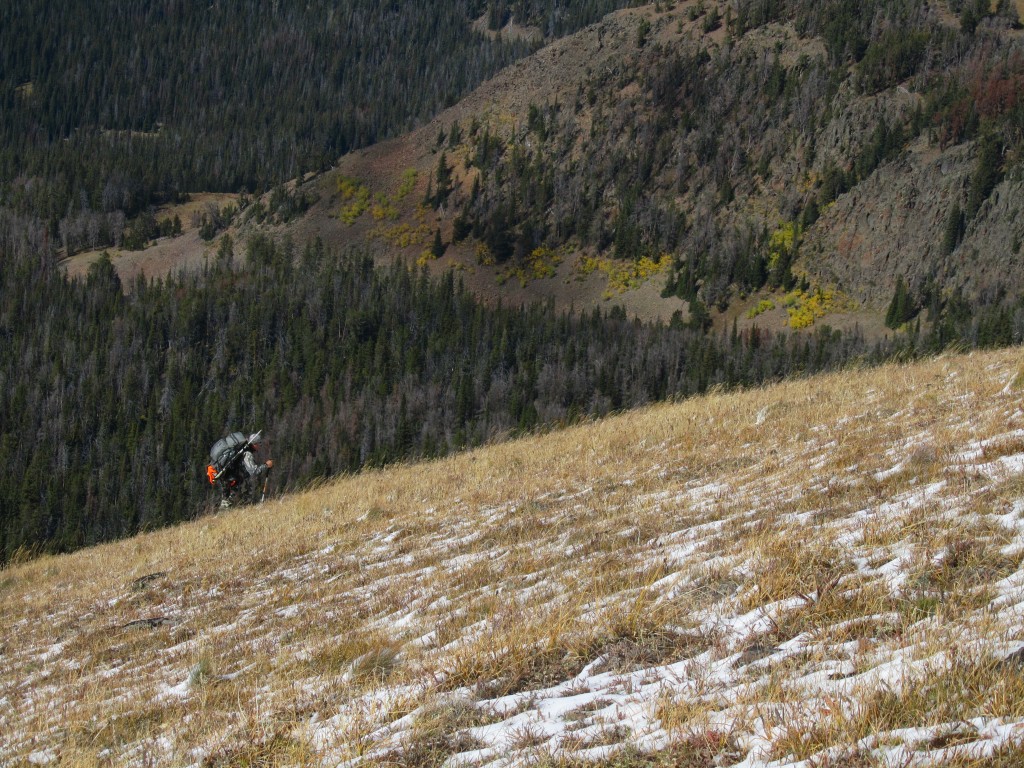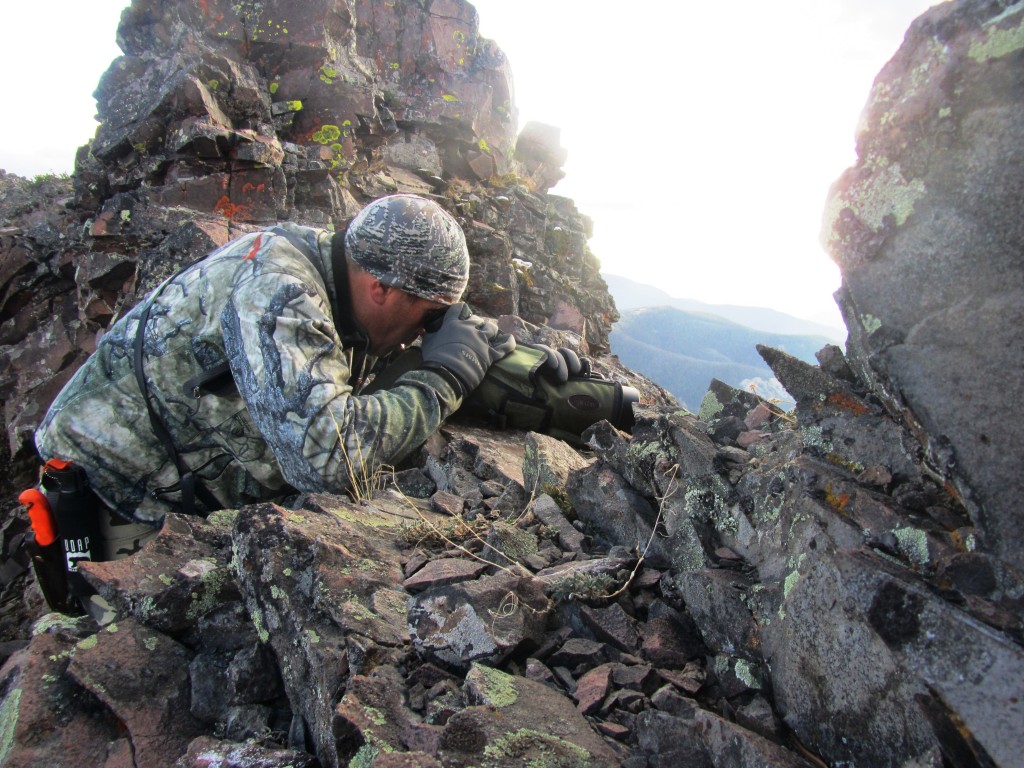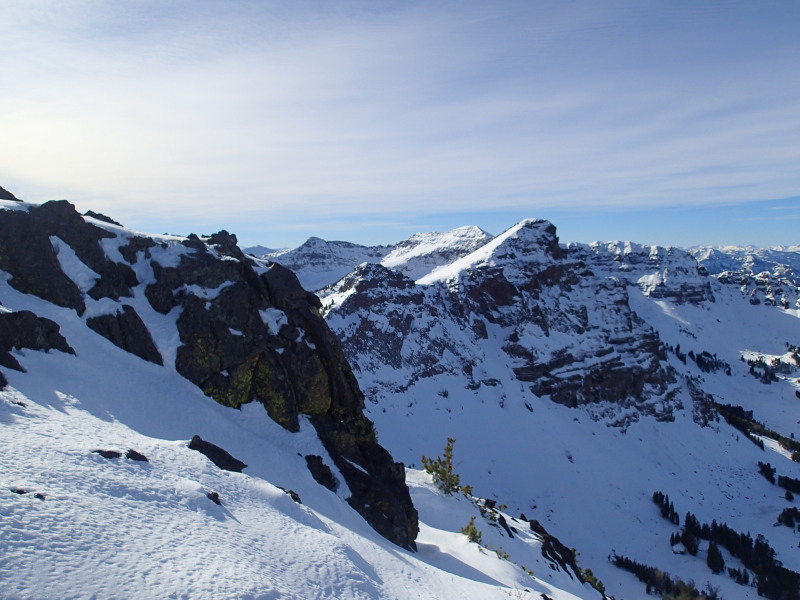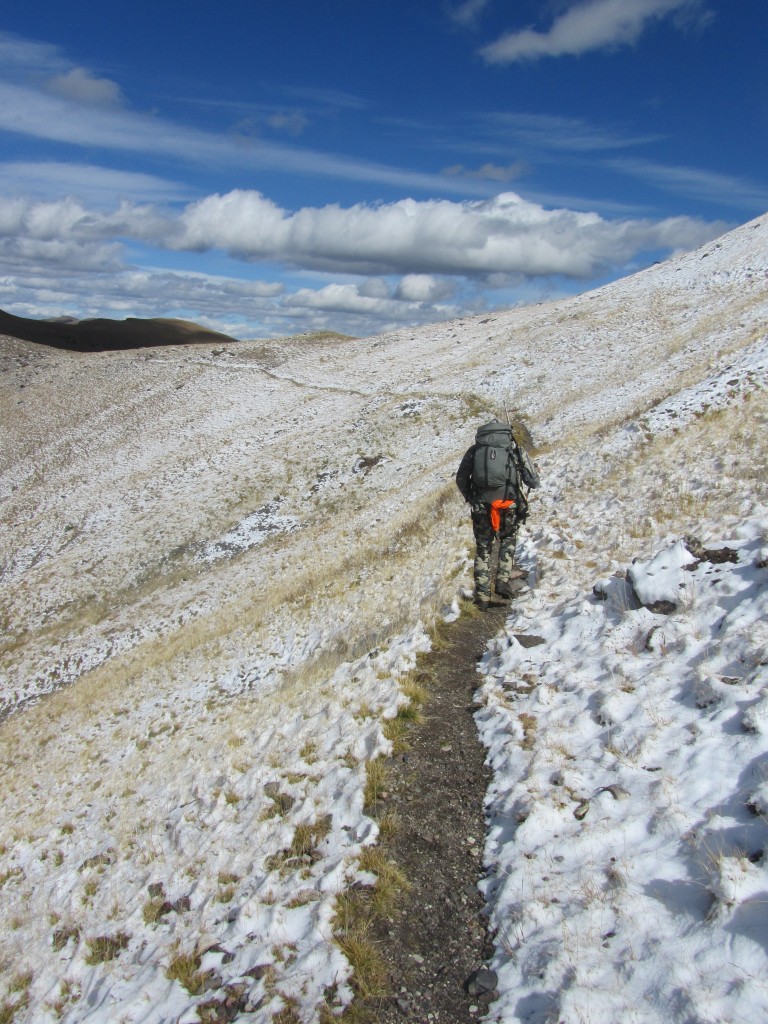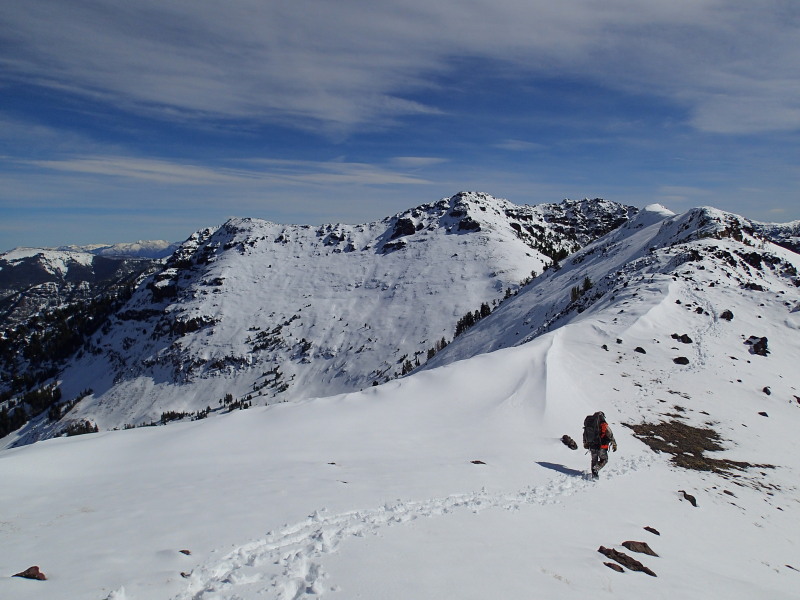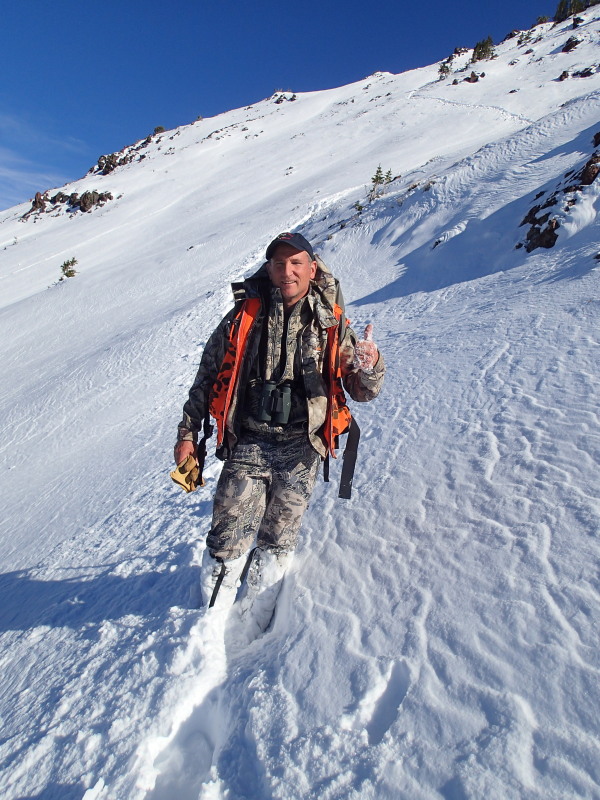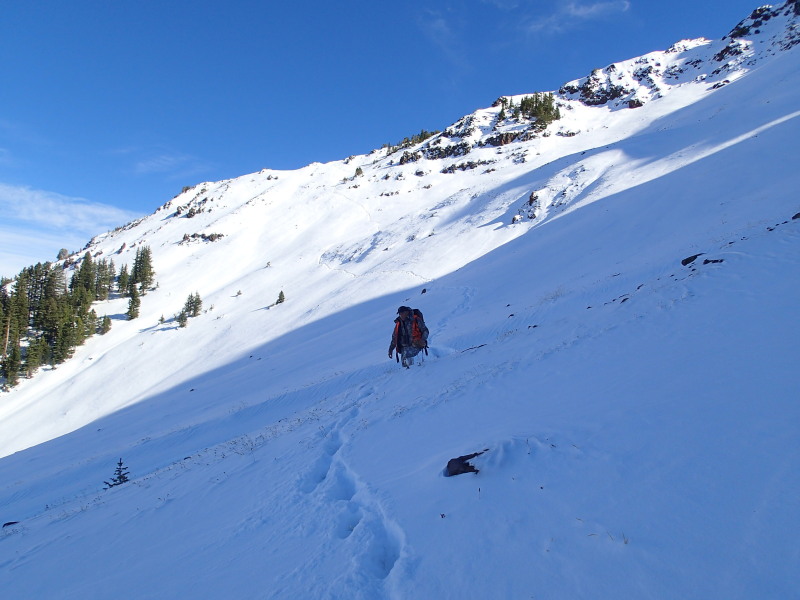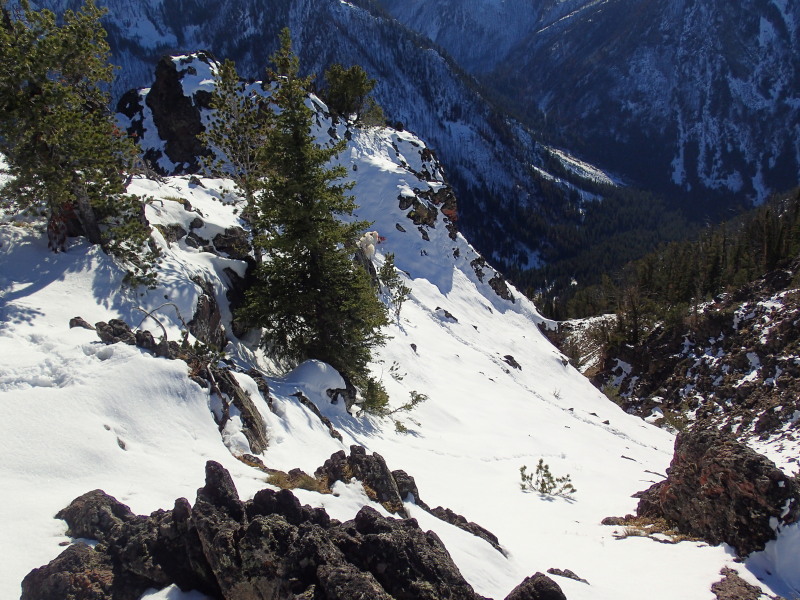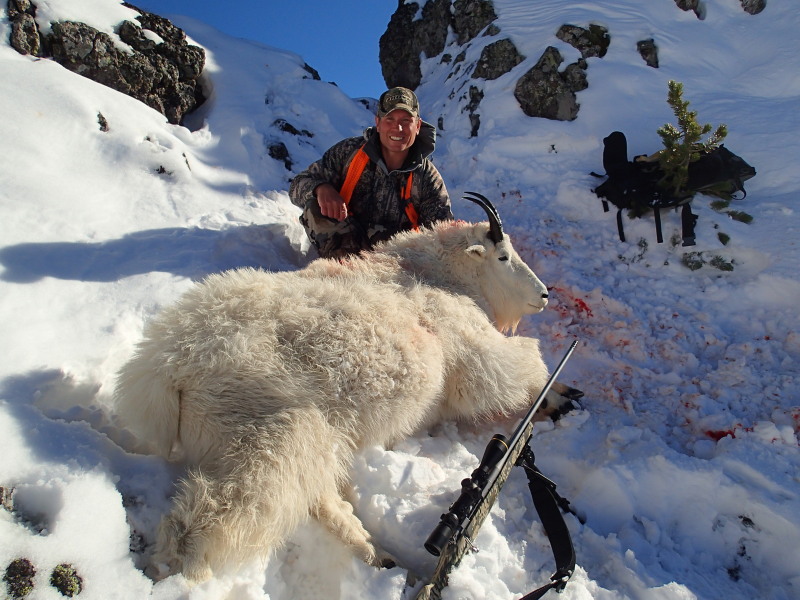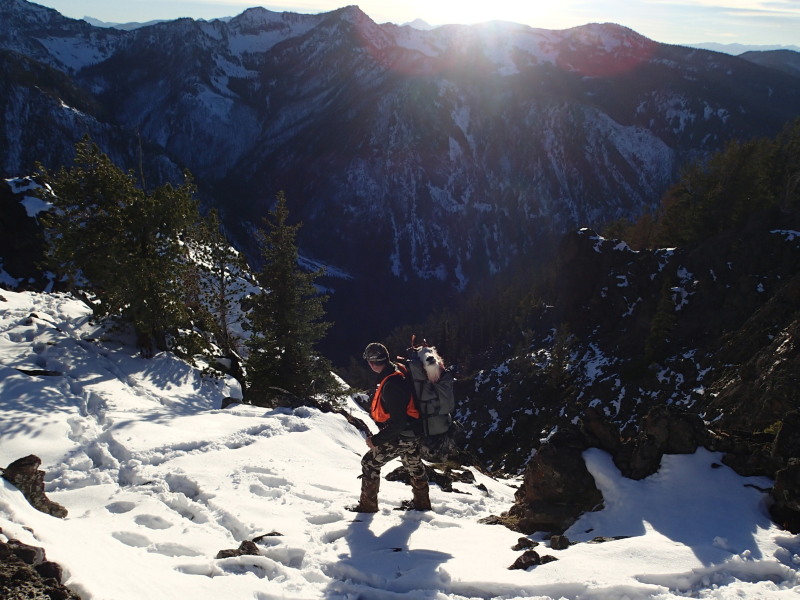It was the end of September and a winter storm was moving toward southwest Montana when Dick and I left our base camp on Moose Creek at 5AM in a light rain and headed toward the top of the Gallatin Divide. Our packs were stocked with only bivy sacks, sleeping bags, a tarp and enough food to last five nights. A last minute decision to bushwhack off trail and try to find a more direct route to the top of the divide proved disastrous and by ten that morning Dick and I were clambering out of the drainage and onto the same logging road we had driven in on the night before. We were no closer to our destination, three miles from our camp, soaked, and five hours behind schedule. Hiking along with few words said, we made it back down the road to camp. There we changed clothes and then followed our original plan to take the Forest Service trail up to the aptly named Windy Pass. Above the tree line, we intersected the divide trail that runs the crest of the Gallatin Range and took it north.
For another five miles we skirted the summits of the peaks jutting from the divide to a series of basins where I had found mountain goats while scouting in August.
It was late afternoon before we had the tarp stretched between a clump of bristlecone pines along the ridge top and our Spartan camp set up underneath. I secured my gear against the howling wind, grabbed my binoculars and started glassing the mountain faces around me. Across the basin over a mile away, several white spots were visible on a promontory below a cliff face. “Goats” I said out loud to Dick who was trying to tighten the lines of the tarp as it snapped in protest to the wind. In a few moments he was at my side staring across the void of the basin. “So, you up for this?” I asked. We had been going hard for ten hours and probably should have called it a day, but I was eager to get a closer look at the goats. “Sure” Dick replied.
We grabbed our packs, now much lighter and trudged down the ridge into a whipping wind laced with sleet. Two hours later we had worked ourselves around the basin rim, crossed a steep face and climbed to the top of a knife ridge above the goats. Peering over the top, I spotted several animals scattered among the rocks several hundred yards below us. Dick handed the spotting scope up to where I was perched and I balanced it on the rocks to take a closer look at the goats.
They were all nannies and kids. But below them further down on the face a small patch of white revealed another goat in the rocks. From my angle I couldn’t see its head. It was bedded on a small outcrop and it would take at least thirty minutes to get to a position where I could get a better view. I looked at my watch. It would be dark in an hour and the wind was not letting up. The goat would have to wait until morning. We lowered ourselves back down from the crest of the ridge and picked our way through rock scree and patches of ice finally reaching the divide trail just as it was getting dark. Back at camp we found the tarp hanging by a single piece of twine, like a tattered flag whipping in the wind from the mast of a sinking ship. My bivy sack had blown into the trees and my gear lay scattered on the ground. We managed to gather our gear and retie the tarp before crawling into our bags and preparing freeze dried dinners. I tucked the hot package of beef stroganoff into my sleeping bag and basked in the heat until my hunger finally won out. After setting the alarm clock on my GPS, I zipped the bivy sack up around me like a body bag and tried to fall asleep while the tarp above us cracked like a whip in the wind.
There is only one thing that you can be sure of when it comes to DIY mountain goat hunting. You can count on getting your ass kicked.
You will find very little information available on the habits of mountain goats or methods used to hunt them. Unlike deer and elk, there aren’t books dedicated to goat hunting. As a species they don’t share the glamour or the enthusiasm the hunting community bestows upon wild sheep. Unlike moose feeding among willows, goats live up high in a no-man’s land, white spots against gray buttresses of rock, only seen from far below. Other than hunters, only the most adventurous souls will ever reach the places where mountain goats dwell. Still there are those of us that dutifully apply for the few mountain goat tags given out each year. After twelve years of trying I was fortunate to drawn one.
But where do you begin? My friend Jesse Nelson warned me that your mountain goat hunt needs to start the day you draw your tag. So I talked to biologists, fish and game officers, and hunters who had drawn the tag in previous years. I learned that on average only 50% of the tag holders are successful in taking a goat. Apparently some hunters don’t understand just how remote and steep the country is and quit, intimidated by the elevation and hostility of the terrain. Others who drew the tag just wait too long and are snowed out of the mountains.
So I needed to not only decide where to hunt in the unit I drew but when. The season runs from September 15th until December 1st. Each time I looked at a calendar I couldn’t help but worry about the snow. In mid September when the season opens the goats are scruffy and haven’t donned their winter coats. But wait too long and you run the risk of heavy snow making access into the high country impossible. I had a few days to hunt at the end of September and then wouldn’t have a chance to try for goats again until October 27th. I didn’t want to waste this once in a lifetime opportunity so I decided to start my hunt on September 25th. So “when” was decided, now “where”. I spent summer weekends scouting the basins and peaks of the units. I saw several groups of nannies and kids and a handful of solo billies.
The highest country of the unit was along the Gallatin Divide, a singular ridge that separates the Paradise Valley and Gallatin Canyon in Southwestern Montana. The entire divide is remote and touches 10,000 feet along most of its length, but there is one stretch that is particularly inaccessible. Eighteen miles separate the Forest Service trailheads at each end of the span. In between, the divide lays protected behind miles of rugged wilderness. It was here that I had found the greatest concentration of goats during an August scouting trip. But it was a long way in. I decided to stay high and stay mobile. We would go in with only bivy sacks, sleeping bags and a tarp, camp at the top of the divide, and move daily as needed to find goats.
I was both excited by the challenge and a little apprehensive about my lack of experience hunting mountain goats in the high country. One night, as I sat in the kitchen studying a topographic map of the unit, I thought of the ancient mapmakers who, knowing not what lay beyond explored territory, simply wrote upon their maps “Here, there be dragons”.
The next morning we stayed in our bivy sacks until it became light enough to see. I figured the goats weren’t going too far from where we had spotted them. I knocked the snow off my bag, crawled out and began scrounging for wood to build a fire. The wind had died during the early morning hours and we enjoyed the respite while warming up and making coffee in the Jet Boil. Vivid spots of blue peeked out of the gray mass of clouds above us. They lulled us into believing that the weather forecast might be wrong. Maybe the weather was breaking and the storm had missed us. Sucker Holes, my brother calls them. I hoped that this time he was wrong.
I set up the spotting scope on a knob just east of camp and soon found the goats. Below them, on a small ledge the single goat lay alone, but it was too far to determine if it was a billy or nanny. We hurried down the divide trail, skirted the top of the cirque and were back at the rock wall and ridge where we had quit the night before.
We worked along the backside to avoid being seen by the goats on our left until the ridge abutted the face of the mountain in front of us. As we crept along, Dick spotted some goats on our right climbing out of the sparse timber of the basin below us. A look through our binoculars revealed kids and nannies and we quickly turned our attention back to the goats on our left. When the ridge ended abruptly against the mountain face, we quietly climbed over the top and dropped to the south side.
Hugging the mountain we inched around the rock wall grimacing as loose scree tumbled down the steep slope toward the goats bedded a few hundred yards below. Amazingly, they ignored the noise and never looked up. After an hour of slipping and sliding we made it around the mountain to the stone abutment that jutted out above the ledge where the single goat had been bedded. I was certain the goat would be there and that it would be a billy. Finally on some level ground we padded silently down a goat trail on the rock toward our quarry. A screen of trees rose from a ravine on our right and through the limbs we spotted a group of goats bedded on a grassy slope less than 200 yards above us. If they had seen us they didn’t act concerned so we stopped to set up the spotting scope and take a closer look. It was the group of nannies and kids we had been seeing for the last two days. Sixteen goats were casually napping or browsing just above us. Two of them were huge nannies, bedded alone without kids and sporting long horns. If it came to it, I thought, I would be happy with either one of those goats. Compared to a mature billy, the bases of their horns were thinner and they carried less mass along the length. They also lacked the telltale curve of a billy’s horns. Both were old nannies, well over nine inches with one looking close to ten. But the season was still young and I had a billy just over the edge of the mountain. I knew the group of nannies and kids would stay put.
Dick stayed back as I inched out on rock above the ledge. Crevasses ran down both sides with pockets along the face. I couldn’t see the goat anywhere. I moved along the ledges, peering down into the cracks and holes of the mountain but the goat was gone.
Maybe it had been a nanny and was now with the group above us on the slope. I looked for another twenty minutes and then climbed back up the mountain to rejoin Dick who was now looking through his binoculars across the drainage further to the south. “I see a single goat bedded out on that rock outcrop way over there” he said without taking his eyes from the binoculars. “I wasn’t sure if I should tell you though because I know you’re going to want to go after it.” He was smiling at me when he lowered his glasses but behind the sarcasm I had detected a hint of real concern.
I looked through my binoculars and found the tiny white speck he had spotted. It must have been two miles away and on the far side of the drainage. I dug the spotting scope out of my pack and even at sixty times magnification it still looked like just a white spot on the rocks. But it was at least in the shape of a bedded goat. “Gotta be a goat” I said. “Gotta be” replied Dick. “Probably a billy” I said hopefully.
The problem was, we had two choices in getting to that goat before dark and neither was going to be any fun. We could climb back around the mountain face on the scree slope, navigate the rock ridge, climb back up to the divide trail and take it around the drainage to a point above the goat and then descend back down 1500 feet. Or, we could just bail off the face we were on, drop to the bottom of the drainage, beeline across and climb back up above the goat. Going back the way we had come was not something I wanted to do but at least all of the variables were known. Looking down into the drainage below us with its forested ridges and basins made me apprehensive. It looked straightforward. Drop down to the gentler terrain below tree line, skirt around the drainage bowl and climb back up to the ridge above the goat. But I have fought my way through enough lodgepole, downed timber, and north facing jungles to know that it wouldn’t be as easy as it looked. It was almost 1 PM and it would be getting dark by 5. The patches of blue were covered in a darkening mass of gray and the wind was starting to howl again. I made a decision. We bailed off the rock ledge and dropped into the abyss.
It was fairly open all the way to the bottom. We found good water coming from the rocks and quenched our thirst and re-filled the water bottles. We made it around the south face of the drainage and began traversing the side of the basin through the north facing timber. At first elk trails made the going manageable, but soon the hillside grew impassably steep and covered with blown down beetle killed pines. “We have to climb out of this” I told Dick and we began pulling ourselves up the mountain using every bush and tree trunk as a handhold. It was almost two hours later when we came out on a bench above the outcrop where Dick had spotted the goat. We moved slowly along the bench, glassing the rocks and ledges below us. The goat was gone. I pointed down the mountain to the gray stone buttress protruding from the mountain slope. “That’s it, right? That’s the outcrop where we saw the goat?” I asked Dick.
“I’m almost positive it is”, he replied. “Well, then he’s gotta be there somewhere” I said. “Let’s get down there”.
We descended five hundred feet down a rocky, ice covered slope to a bench which jutted out from the mountain for fifty yards to form the outcropping where the goat had once bedded. Twenty feet above us we spotted a cave entrance in the cliff wall. The wind was now buffeting us and it had begun to sleet. We decided to climb up to the cave to rest our legs and take a break from the wind The cave was really a deep hole under a ledge, carved out by millions of years of wind and water. Generations of goats had used this as a place of shelter and white goat hairs littered the dry dirt of the floor. I dug out a Clif Bar and stretched out to take as much load off my tired legs as I could. I contemplated the situation. The wind had just started to come up when we first spotted the goat. Now it whipped around the drainage, forty mile per hour gusts stinging our faces with pellets of sleet. I looked down at the outcropping and thought that no goat in his right mind would remain bedded and exposed to that wind out on the rock. No, he would seek shelter just as we had. We finished our break and dropped out of the cave to the bench below. Moving along the mountain slope toward the outcropping, we passed above a ravine that ran down the length of the outcrop towards the basin below. Pine trees grew in clumps from the bottom of the ravine. With each step, I glassed every inch that I could see. My binoculars passed over a small patch of white visible through the branches. At first it I thought it was snow but it seemed out of place and there were no other snow patches visible in the ravine. I moved slightly to my right and the patch grew larger and had a definite yellowish hue. “I think I found him” I whispered to Dick.
The pines closed around the goat as we moved closer to the outcrop and the white patch was lost from view. It was the most of the goat we were able to see but I was sure it was our billy. I climbed out on the outcrop above where I thought the goat was bedded against the east wall of the buttress where it met the edge of the ravine. Mindful of the gusting wind, I leaned over the edge as far as I dared. There straight down and fifty feet below me was the billy nestled tight against the wall. I could have dropped a rock on him but there was no way to get far enough out over the edge to get make an ethical shot. I looked back at Dick and pointed down toward the goat, mouthing “He’s right there!”
We both looked around for a solution to our conundrum. We were standing fifty feet from a big billy and could not get a shot at it. It was obvious that the only course of action was to climb back up the mountain and drop down on the other side of the ravine. From there we could work our way through the trees across from the goat and hopefully make a relatively easy shot. I crossed my fingers that the goat would stay put until we got there. Thirty minutes later, I was sliding across the slope on my butt six inches at a time. I could see the billy more clearly through the trees but couldn’t get a clear shot. Dick held back as I made the final stalk on my rear end. I had the bi-pod extended for a sitting position shot if luck would stay with me. After all of the hours and miles and hard work, it was coming down to a few feet and minutes. I kept telling myself to be patient but I was growing increasingly worried that the goat would get up and move and leave me without a clear shot. I crawled carefully across a downed log and resumed my seated position on the steep slope. I could now see the entire goat through the trees only 150 yards below me. He was bedded and looking away from me, having no idea what lurked on the slope above him. Through my scope I stared at his heavy black horns which swept back past his ears. He was heavily furred and the width of his head indicated maturity. This was the billy I had been looking for.
I settled comfortably behind the little Kimber rifle. The certainty of the outcome erased all of my jitters. Patience returned. The billy was as good as dead already. I just wanted to wait for a better angle for the shot.
Minutes passed like hours and finally the billy stood, perhaps to walk off, perhaps to just move to a more comfortable position and turned sideways. I focused on his shoulder moving the crosshairs to the lower third. The rifle would shoot a couple of inches high. I exhaled and started to squeeze. The bark of the rifle caught me off guard shattering the mountain air as the billy collapsed, kicking and sliding down the slope into a clump of trees. Then there was nothing but the ringing in my ears.
I looked back at Dick, grinning and gave him the thumbs up. We had done it! We had killed a mature billy on a DIY hunt in tough conditions.
I heard movement in the trees and shot an inquiring glance at Dick who had heard it too. “He’s up and moving!” Dick said and then there was a crash and Dick, looking into the trees saw the goat fall. From where I sat I couldn’t see the billy but I could tell it was no longer moving. Dick walked over and we exchanged congratulations and he graciously offered to climb back up to the bench to recover the packs. I was more than happy to let him. Suddenly I felt physically and mentally drained as the adrenaline in my veins waned. I was still on an emotional rush though and I wanted to savor the moment. I drew in a deep breath of the mountain air. I drank in my surroundings. I stared at my bruised and bloody knuckles. “Remember this moment” I told myself. Then I waited for my friend to return with the packs and climb down with me to see our goat.
Dick was back in twenty minutes and as he made his way towards me I asked him to take a few pictures. I threw my camera to him where he stood thirty yards to my right. He snapped a couple of pictures of the ravine and a couple of me still planted on my butt where I made the shot. But as he started walking toward me, I heard movement again in the trees below. “He’s moving again!” Dick shouted and before I could get to a place where I could see the goat clearly Dick had watched him slowly walk down the edge of the ravine around the end of the outcrop and out of sight.
There are those moments and decisions which we want so desperately to have back. I could have made my way down to the goat immediately after the shot and this story would most likely have a different ending. But it was a steep descent down to where he lay in the trees two hundred yards below us. I wanted Dick to be there when I approached the fallen goat. He hadn’t pulled the trigger but other than making the shot he had earned this goat as much as I had and I was grateful for his help and companionship on this hunt beyond my ability to convey in words. So I decided to wait until he retrieved the packs before climbing down to the goat.
But now the goat was gone. We would look for sign for the next hour as the light began to dim in the canyons of the drainage. We found footprints in the snow where the goat walked along the ravine but no blood and when the goat turned into the rocks we lost those too. The wind was gusting, the temperature dropping and it was beginning to snow. It is in that moment when the decision is made to abort the search that you feel the despair begin rising in your throat on wings of guilt while your confidence falls into a pit of disgust and self pity. These are the moments when I question my desire to do this. Wounding an animal, causing it to suffer as a result of my actions, is an excruciatingly emotional experience for me. While I remind myself that animals endure a hard life where death and injury are constant companions it is an excuse thinly veiled. But right then I had a bigger issue to confront. We were a long way from camp, far down on a dangerous mountain face, worn out and it was getting dark.
Exhausted, Dick and I make the mistake of getting separated as we climbed the mountain. As I moved around the edge of the rock face he was suddenly not there. Tired, I had lagged behind and lost him. I spotted what appeared to be a climbable chute in the rock wall and started up. The wind was so strong it caused me to flatten against the rock as gusts tore at me, threatening to blow me off the wall. After fifteen minutes I could go no further, it is too steep and I lack the confidence and strength to make the pull up the final thirty feet. Going down is always harder and by the time I pick my way down the chute I am sure Dick must be halfway back to camp. I find another route and make it to the top of the wall in time to see Dick come around the face down below me. He has obviously come back looking for me. He follows my first route up the chute and makes the final thirty feet look easy. We give each other shit for getting separated then relieved, start the climb up the ridge. Two hours later we stagger into camp, crawl into our bags and hunker down until morning. I toss and turn all night thinking about the goat, the shot.
The next morning when we woke the wind was still blowing and it was snowing hard. The clouds settled onto the mountains, obscuring visibility past 100 yards. Our water was gone. After we managed to start a fire, I grabbed all of the empty water bottles and dropped off the backside of the ridge into the basin below camp. I knew there would be a stream somewhere below at the head of the cirque that forms the basin. I descended down through the fog keeping my eyes open for bears and finally found water about a mile below camp. Climbing back up I felt every step of the last three days in my aching legs. It was snowing so hard that I had to follow my fast disappearing tracks to find the clump of trees where we made camp. After eating I made the decision to break camp and get out of the mountains. Conditions were deteriorating rapidly and we were both exhausted. Returning to the site of the shot last night was now out of the question. The day before Dick had told me he was as tired and worn out as he had ever been in his life. This was a serious admission coming from a guy who is one of the toughest people I know.
During the night I had also come to the conclusion that I must have not fatally hit the goat. I had pulled the shot, aimed too high, hit an unseen branch. Something must have happened and surely the goat was still alive and would recover fully. It was probably wishful thinking but I needed to feel better and get out of the funk I was in.
I told Dick my plan. We would pull camp and head back south to Windy Pass. If it was still socked in when we got there we would call it a day. If the clouds lifted we would continue south three more miles to Eaglehead Mountain where I had seen a billy in early September. If we hadn’t spotted him by 3 PM we would head home.
At the Pass the clouds were giving the appearance of lifting so we took shelter in some trees, built a fire and ate some lunch hoping the weather might break but it never did. Neither of us really cared. We made it down to the truck by two in the afternoon and by the time we got within cell phone service I already had several text and voicemail messages from my brother and friends warning me about the winter storm that was beginning to dump on southwestern Montana. “If you get this message”, they all said, “you need to get the hell out of the mountains… now”. At first I chuckled at the futility of it. If I was still up there I wouldn’t have heard there warnings anyway. Then I realized that they really had no responsible choice except to try. It’s always comforting knowing there are people out there who have your back. Dick and I got to the house, showered and headed for the Oasis to lick our wounds.
By Thursday it was pretty much all over. Almost a foot of new snow carpeted the highest elevations of the Gallatin Range. It was less than was forecasted but still a pretty good dump for September. Dick and I were leaving for Wyoming to hunt antelope on Saturday but I wanted to take one more shot at a goat before I left so Friday we got up early, climbed back to the divide through the snow and made our way south along the divide trail to Eagleh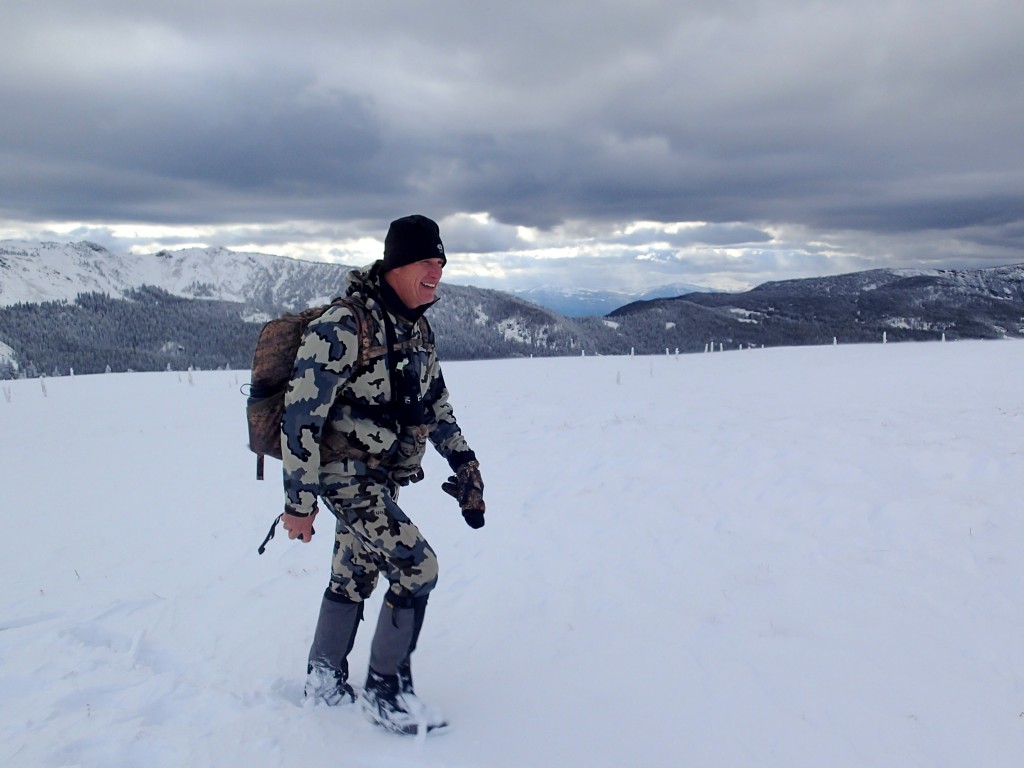 ead Mountain.
ead Mountain.
It was still windy and now bitterly cold. Dick spotted a decent 4×4 mulie buck bedded in the snow with two does as we plowed along the trail. He was only 100 yards or so away but he didn’t even bother to get up. Fortunately for him my 2013 deer tag was already punched. When we finally stood in the shadow of the mountain, Dick got a fire going back in the trees as I glassed the mountain’s face. I quickly discovered how much more difficult it is to spot a white animal once there is so much snow. Wisps of clouds moved across the mountain further obscuring the view. Dick and I took turns glassing and manning the fire before calling it a day and heading back down the mountain.
The next day, we picked up my friend Tom Brooks in Gillette, WY and made camp thirty miles north of town on the Thunderbasin National Grasslands. Dick took a nice antelope buck the second day of the season and Tom missed a dandy. Then the weather started to turn. Winter Storm Atlas was moving across the western plains and headed right for northern Wyoming. We hunted hard right into the mouth of the storm trying to get Tom a buck only to wake Friday morning to almost a foot of snow. Tom and I would have to eat our Wyoming antelope tags. We pulled camp and made it into town in a driving blizzard only to find the interstate closed from Gillette to Billings. Dick and I dropped Tom off at a hotel and scooted out of town on a snow drifted two lane highway that ran north to Ashland, Montana.
Eight hours later we limped home with a truck load of snow and wet gear. It had been too dark to see the mountains surrounding the Gallatin Valley as we drove by Bozeman but they were on my mind. The weather forecast was warning of multiple feet of snow in the higher elevations before it was over. I wondered if the storm had driven the goats lower or would they still be clinging to the highest peaks now made even more inaccessible by deep snow. It was only the first week of October. I remembered the two reasons I was told that on average only 50% of the mountain goat tag holders would be successful in my unit; either a hunter was too intimidated by the terrain or they waited too long and were snowed out of the mountains. I told myself I still had plenty of time but this storm was increasing my anxiety about getting my tag filled.
By Saturday morning the storm had passed and the snowfall wasn’t as severe as predicted. Most of the snow had missed the Gallatin, leaving only a foot in the highest elevations. Dick took off early that morning for Idaho to get ready for our elk hunt in the St Joe. I would leave Bozeman on Tuesday to give us time to set up camp on Wednesday before the season opened on Thursday. I spent the morning getting the mess that had been our antelope camp sorted out. I hung the wet tent in the barn and laid the sleeping bags and pads out in the basement to dry. My head was still in a bad place over the goat I had shot. I was struggling with the idea that I might have killed him and he was now likely under a foot or two of snow up in the basin. There was a part of me thinking I should hang it up and try to find his remains in the summer when the snow had pulled back from the highest elevations in July. Arguing against that plan was the nagging doubt that maybe I had only slightly wounded the goat and he would survive. This was my once in a lifetime chance at a Montana mountain goat and I needed to grab this opportunity, quit wallowing in self pity and get my ass in gear. I headed into town and found myself walking into Schnee’s Powderhorn sporting goods in downtown Bozeman to get my head set straight. Pete Muennich heads up marketing at Schnees and took a nice billy in the same unit in 2012. Jon Edwards is Schnees general manager. Both are accomplished hunters. These guys also understand that it’s the overall experience of the hunt, not the killing of a trophy animal that matters. Pete was off that day but Jon listened patiently as I told him about the goat I had shot and shared my conflicted emotions about continuing the hunt. Jon on gave me the pep talk I needed and talked me off the ledge. So when my brother Dan called that afternoon and asked if I wanted to hunt on Sunday and see if we could find a billy, I was all in.
I was up at 3:30 AM to put the horses on feed, fix sandwiches for lunch and make coffee for the drive up Hyalite Canyon. By 6:30 we were in the saddle and riding through fresh snow towards the top of the drainage where I had spotted goats in the summer. The snow was over the horses’ knees by the time we hit the base of the steep slope that climbed to the rim of the cirque. The switchback trail to the top was obscured by snow that had blown off the rim and settled in deep drifts across the face. There would be no riding to the top. The horses were tied up in a clump of trees and we pulled our packs out of the panniers and started slogging up through the thigh deep snow. I had brought my Stone Glacier pack but Dan had only brought a small Sitka day pack. To balance the pack saddle we had pulled the food and water bottles out of my pack and they were still sitting in the bottom of the pannier when we began our climb up the face. It was a mistake that would come to haunt us later.
The southern rim of the cirque was a thin saddle connecting Elephant and Blackmore Mountains. The backside of the rim dropped precipitously down into another deep basin surrounded by vertical cliffs on three sides. While scouting I had seen a good billy on the face across the basin but today there were no mountain goats clinging to the icy ledges, so we turned east and started climbing the rocky ridge that ascended to the summit of Elephant Mountain. After making the top we traversed a knife ridge to the south and settled in to glass.
To the east, bedded on a small outcrop was a small goat. Thankfully it wasn’t a mature billy as getting within shooting distance, let alone getting to the goat would be impossible. Looking back across the basin on the east face of Blackmore I spotted a nanny and kid climbing up through the rocks. Eventually they crested a ridge and dropped out of site. At least we were seeing some goats. We dropped off the ridge and traversed an almost vertical face, the fresh deep snow giving us purchase but the pucker factor was still there.
We made the saddle, climbed halfway up the southern face of Blackmore and began circling to the west, glassing the steep cliffs below us. Finally the mountain became too steep to continue and we circled back around the mountain to a ridge on the north side. This time Dan was the first to spot the goats. Over a mile away, below the ridge running from the west face were five goats. I set up the spotting scope to take a closer look. They all appeared to be billies but only one stood out. His horns curled well past his ears and even at this distance I could see his heavy bases. “Take a look”, I told Dan, “the one on the right is a really good goat”.
Dan looked at his watch. He had to be at work at 8:00 the next morning. It was 2:45 PM and it would be dark by six. To get to the goats we would have to drop over a thousand feet off the ridge, traverse the basin below us, climb back up to the top of the ridge and travel a mile along its rocky spine. And we hadn’t had a drink or any food since 4 AM. “I can come back tomorrow”, I offered. “I’ll go up the Fox Creek trail and then south to the ridge.”. I knew if we went after the goat it would be a long night. I also knew I would probably never make it back in alone the next day. But I needed to give Dan an out. It was a lot to ask. We were already fried. We had been up since 3:00 AM, had ridden almost three hours, and had climbed two 10,000 foot peaks to be standing where we were.
“Well, we came here to hunt mountain goats”, Dan said. “I’ll give you till 5 PM to shoot him and then we have to head back to the horses”.
We bailed off the ridge, dropping into the basin in an avalanche of thigh deep powder. I tried not to think of the climb back out. We made the bottom and climbed to the ridge, still almost a mile from where we had spotted the goat below a rocky pinnacle. It would be our guide to where the goat was last seen on the southern slope. The ridge top was a knifelike edge of rocks and boulders only one to four feet wide. In places we were forced to drop off the top and work around steep cliffs. It took longer than I expected to get to the rock pinnacle. I paused to look back at the path we had taken, imagining the return trip encumbered by 100 lbs of goat hide and meat.
We had last seen the billy feeding on the slope about 200 yards below the rock pinnacle. We decided to first move slowly around the bottom of the rock buttress to make sure we couldn’t see the billy from the south side of the rock. If not, we would climb to the top and hope to see him before he spotted us. Thick bristlecone pines flanked the southern face below the rock pinnacle and I had little hope of spotting the billy from our position. My rifle was still slung on my shoulder as I moved around the rock.
A flash of white startled me as the billy leapt from his bed and scrambled around the rock face to my right. I tried to un-sling my rifle but it caught on my backpack strap. I wrestled it free but the billy was gone. He had to be close. I waved to Dan to move up and help me find the goat. Where was he? The ledge he was on dropped into a deep ravine. Then I spotted him 175 yards away climbing the far side of the ravine toward a saddle in the rocks. In seconds I flipped the bi-pod open, dropped prone and found the billy in the scope as he reached the gap. Just before he dropped over the back side, he paused and turned to look back. The crosshairs nestled low behind his shoulder and the Kimber Mountain Ascent barked.
My brother had heard all of the stories about how tough goats were. He didn’t want me to lose this one. “Hit him again! “ Dan yelled as the goat dropped. The billy rolled, belly toward me and I sent another round into his brisket. “Hit him again!’ Dan was still yelling, but the last round had pushed the goat over the edge and out of sight. I had a clear picture of both shots. I knew the goat was dead. Dan wasn’t so sure and was urging me to get to the other side of the ridge where the billy had dropped.
We circled around the head of the ravine and climbed to the top of the rock pinnacle. Down below the billy lay on the slope on his back, quite still. Which was fortunate because it lay at the to of a steep slope and it would not have taken much to send him hurtling down the ravine. The goat is visible in the picture below.
I looked through my binoculars but most of his head was buried in the snow. It had all happened so fast. He had looked like a good goat but I never got a good look at his horns as he plowed up the side of the ravine. There had been five billies and only one had stood out. We slowly made our way down the rock face to the where the billy lay. I took off my pack and laid down my rifle and then ran my hand down the silky hair of his belly. Just to touch such a mythical beast. This was not like any animal I had ever hunted before.
I reverently lifted his head from the snow, the long heavy curved horns were the last to appear. He was a mature goat and all that I had hoped to harvest when I drew the tag. I cared not if he made the record book. He was perfect and the hunt had been perfect and for that moment all was right in my world.
We took some pictures and then began the work of skinning the goat. I marveled at the size of his hooves. Almost as big as an elk bull’s. Under the long guard hairs of his coat he wore a two inch thick felt wool mat. It was difficult to cut through even with a sharp knife. The slope he lay on dropped into another deep ravine. Several times he started to slide down the mountain and we wrestled him back into place. An hour later it was done and the entire goat hide, head and boned out meat was tucked into the Stone Glacier Pack. And that was the problem. The pack probably weighed well over 100 pounds. And we were a long way and a long climb out of the basin from the horses.
It was after six when we started out and the sun was setting. The temperature began to drop and the fatigue began to set in. I made it most of the way back along the ridge before finally giving out.
Dan shouldered the pack as we dropped off the ridge down into the basin. Step by excruciating step we began the long climb back up through thigh deep snow to the ridgeline that separated us from the horses. Coming down the steep slope had been relatively easy in the deep, soft snow. Now Dan struggled under the weight of the pack, every step a challenge as the snow broke loose under his weight and dropped him to his knees. Hours passed and the stars came out, the wind came up and it became very cold. Dan’s leather gloves had become wet after stumbling into the snow and Dan had taken them off. He was grasping an impromptu walking stick to help him balance and I noticed in the glare of my headlamp that the top of the stick and his hand had become a solid mass of snow and ice. “My hands are frozen” he said and so I peeled my off my gloves and forced them down over his red and numb hands. The pain was immediate as his hands began to burn from the frostbite. It was at that point, he told me later, that he was really beginning to doubt if we could make it out with the goat that night. That we might have had to abandon it to save ourselves. Then his headlamp failed. It just quit working and mine was already dim and almost out. Fortunately I had grabbed a second headlamp and thrown it in my pack that morning. I fished it out as Dan’s hands thawed and we started slogging, a slow step at a time using the one good headlamp, to the top of the ridge. When we crested the ridge after 9 PM we knew the worst was over. But we had had nothing to eat or drink for fifteen hours and we were still an hour from the horses. As we began our descent into the basin my hamstring cramped into a knot the size of a baseball. I dropped writhing in pain in the snow. When I tried to get up it cramped again. Dan came back up the hill to help me to my feet and I wondered what else could go wrong at this point. My hands and fingers were cramped into arthritic claws and I only made it a few hundred yards before the cramp in my leg sent me sprawling into the snow again. We were both terribly dehydrated and Dan was beginning to cramp up too. We were still a long way from the horses when he hit the ground with his own knotted hamstring. I offered to take the pack but he brushed me off and ignoring the pain, disappeared into the dark too worried about the horses to slow down. They had now been tied up since 8 AM. If they had gotten loose we were in big trouble. I limped along, watching his headlamp grow dimmer down the mountain. Fortunately the horses were fine. It was after 10 PM when we finally staggered into the clump of trees where they were tied. Dan dropped and lay motionless in the snow as I dug the water and food from the pannier. It had been that kind of day and that kind of night and we were still a two hour ride from the trailhead. By the time we loaded the packs in the panniers and started down the trail I was too numb from cold and exhaustion to care about anything but getting the hell out of the mountains and into a warm bed. The horses had the same idea and we didn’t have to coax them to make good time on the way back to the truck.
I woke the next morning still tired, but with that satisfied feeling that only comes after surviving such a physical excursion into the wild. I made coffee and fed the horses before opening the tack room door where my pack lay. I pulled the goat’s hide out and lay it on the floor then carried the meat into the house to process and vacuum pack it for the freezer.
I didn’t want to care about how long or heavy the goat was but after dropping the meat in the freezer I couldn’t resist grabbing the tape and measuring his horns. He had 9 5/8” length on the long side and 6” diameter bases. When I checked him in later at the Fish and Game office the biologist told me it was the largest billy to come out of the unit in some time.
My 12 year quest for a mountain goat had ended.
So I am more than happy to share some of the things I have learned after my first and likely last season of mountain goat hunting. I learned that mountain goats do look up; that almost all of the goats that you see will be a long way off; that just because you spot a goat does not necessarily mean you can get to it, before you start your stalk on a goat you will need to take into consideration where it might fall after you shoot it; that unlike elk and deer, mountain goats stay high in the mountains all winter, and that a single, white goat is not easy to spot after it snows.
I suppose there are some goats that come easy. During my late summer scouting trips I spotted groups of nannies, kids and younger Billies feeding and bedding on grassy slopes far below the summit peaks. In Montana, nannies are legal. Most people can’t tell a nanny from a billy anyway. This is especially true when only the front half of the goat is sticking out of your den wall, eliminating proof of the most telling difference. So if a hunter isn’t too particular about the sex of the goat they harvest, they can possibly avoid a lot of discomfort by settling for a barren nanny.
This is because older, mature Billies are a different creature. Like grouchy old men, solitary and intolerant, they live far from the herds of nannies and well traveled Forest Service trails. They cling to the most vertical, unforgiving and sometimes unreachable real estate in the mountains. Which is why we love to hunt them.
Now, some months later, I look back on the fall of 2013 with the greatest admiration for mountain goats and the country they live in. I recall Dick saying to me one day as we padded along down a trail that the thing that kept him going was his knowing that I couldn’t even apply again for seven years. We both laughed at his joke but I think he was being kind of serious ! Anyway, given the draw odds, I will be about 72 before I draw another tag. It doesn’t keep me from thinking about hunting them again though. Maybe British Columbia or Alaska?
To pursue them is to venture into the wildest, most amazing places. The most incredible country one can imagine. It will challenge you physically and mentally like no other hunt. And somewhere, high on a mountain, deep in the wilderness, when you are cold and tired and reaching deep for that last bit of energy you possess to keep going, you will be reminded once again that we humans can suffer for a long time before we die.

